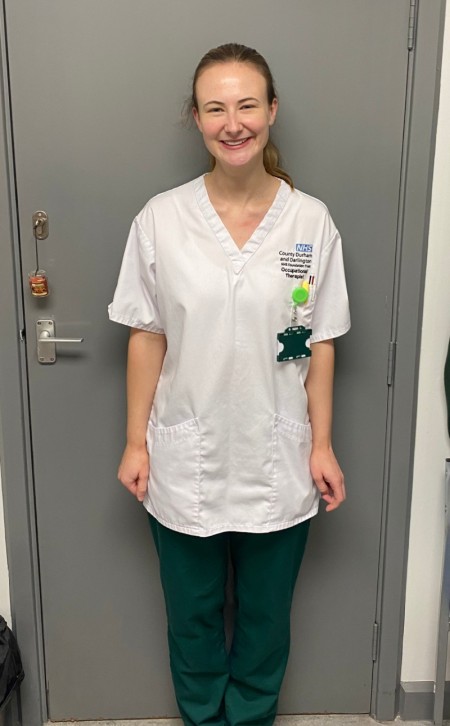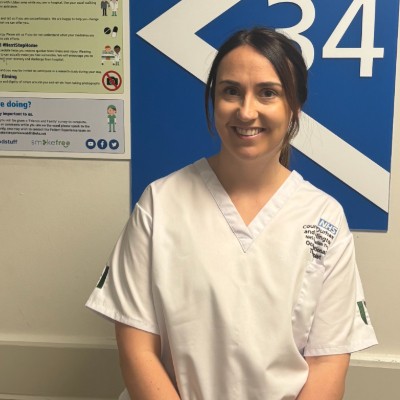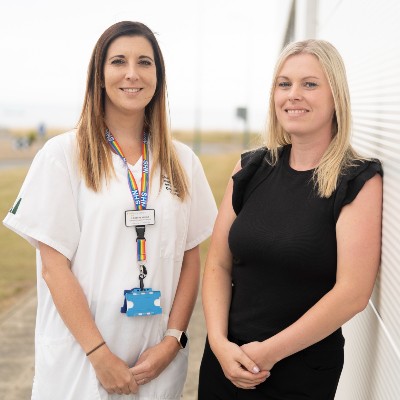Demi Womack was born and raised in Middlesbrough and after living and working in various place within the UK she settled back in her home town in 2018. She has worked as a physical health, adult OT in a rotational post for County Durham and Darlington NHS Foundation Trust (CDDFT) since she graduated from Teesside University nearly two years ago.
Here, Demi gives us an insight into her typical week as Rotational OT in an acute hospital
Monday

Following this I complete morning administration. This includes; a comprehensive review of all new referrals, sent through the EPR (electric patient record) system; and a read of all new medical notes of pre-existing patients on the OT caseload.
Following this, the team break out into sub team huddles, to determine priorities for the day and delegate tasks. No two days in the life of an OT are the same and this week I’m spending 2 days on the elderly care wards and 3 days on surgery and orthopaedics.
9am - I attend huddle on the elderly care ward. After this I catch up with the wards discharge coordinator to clarify caseload priorities, discuss planned discharges and identify new patients that require OT input at a later date.
My first priority is a gentleman, aged 89 years who is planned for discharge home later today. Upon review of his notes, he was admitted following a mechanical fall. He had been reviewed by one of my advanced OT colleagues in the acute frailty team on admission 5 days prior. The comprehensive geriatric assessment (CGA) completed by my colleague has most of the important information I need regarding the patients home environment and usual level of function to inform my assessment.
I check our supplier Medequip for equipment but this patient does not have any previous aids prescribed. The gentleman has been reviewed by the physiotherapy team and was recommended to transfer to a rehab bed for further input, but he is keen to return home to his bungalow that he shared for over 40 years with his late wife. Physiotherapy have agreed to refer for ongoing therapy in the community to increase his confidence and distance whilst mobilising.
After a comprehensive assessment including further information gathering, a functional review of transfers and a telephone conversation with the patient’s daughter and next of kin; I plan to order the patient a range of equipment aids. Equipment includes, a ‘caddy’ (trolley for transporting items around the property), ski’s (to enable the wheeled walking frame to glide freely on carpet) and a 4” raised toilet seat (to aid toilet transfers).
The OT assessment has also highlighted that the patient has been low in mood due to feelings of loneliness since losing his late wife 2 years prior. With consent from the patient I plan to refer to age UK for befriending and bereavement services. I have discussed information regarding falls alarms for the community and I plan to refer this gentleman to the falls team for further input at home.
My afternoon consists of more assessments, note writing and driving the pool car to patient’s property to meet with NOK to deliver and fit equipment. On return to the office, I find one new referral via EPR, I review notes and speak to the nurse looking after this patient, who confirms this patient is awaiting a SALT review tomorrow therefore I prioritise this patient for tomorrow morning.
Tuesday
After lunch today, one of my colleagues has prepared a presentation for our in service training, this month’s theme is ‘Reflections of practice’. The session only lasted 20 minutes but it’s incredibly informative and reminds me of the importance of reflecting on clinical practice and using standardised reflection tools. I write a quick reflection this afternoon regarding a complex mental capacity case that I had been involved in recently and add it to my continued professional development (CPD) portfolio.
Wednesday
This morning I visit the day surgery unit and pick up one new patient following a planned total hip replacement. The patient is 2 days post operation, and her mobility is progressing well with the physiotherapy team and she has potential for home discharge today, therefore I schedule contact this afternoon. After this I attend the Multi-Disciplinary Team (MDT) huddle on the orthopaedic ward. The huddle highlights another priority that could be discharged today following OT input.
The lady is young, she has a full leg cast following a motor cycle accident and multiply fractures. The lady is unable to manage her mobility on the stairs, therefore plans to be downstairs living and will therefore require toilet equipment to facilitate this. The ladies family agrees to take equipment home from the ward and I’m able to discharge this patient with provision of a commode and a going home booklet.
Following lunch we have our afternoon OT team huddle to review afternoon priorities and delegate tasks as appropriate. The OT covering the general medical ward today is struggling to meet the demands of the caseload therefore I agree to see a medical patient after reviewing the total hip replacement patient. I educate this patient regarding hip precautions and demonstrate safe bed transfers and discuss dressing techniques. It’s around 2.30pm now, I manage to see the medical patient and it’s evident that they would not be safe for home discharge today.
During the functional assessment this patient becomes very unsteady on her feet and reports dizziness. I instruct the patient safely back to the bedside chair and provide a handover to the nurse looking after her. I advise that my team would re-review this patient tomorrow but that the medical team should complete a review regarding new dizziness. It’s almost home time when I return to the office, so I decide to write up my notes in the morning.
Thursday
My day starts with documentation. I capture my clinical reasoning in writing whilst it’s fresh in my memory and make sure it’s signed off on EPR before I start the rest of my days’ work.
After morning administration I return to review the dizzy patient from the following day. The medical team inform me that she requires further medical investigation, therefore I discharge this patient and ask for the ward to re-refer when she is closer to discharge planning.
This afternoon I accompany one of my senior OT colleagues on a planned home visit for a patient with new moving and handling requirements. We completed a comprehensive environmental assessment to ensure the patient can be cared for at home by 4 times daily care calls and educate the patients wife and son on how to use a Mo-lift standing aid for bed to chair and bed to commode transfers. Upon return to the office I complete a moving and handling risk assessment and order equipment from Medequip for next day delivery.
Friday
I have a student OT starting a placement with me next week, so she visited the office this morning. I introduce her to the team and completed the mandatory induction and issue her a new starter pack. This afternoon it’s very quiet for a Friday afternoon so I have the opportunity to catch up with some online mandatory training and check in with my supervisor during supervision.
Read about a typical day in the lives of other Occupational Therapists working in different roles for both Durham County Council and the NHS:




